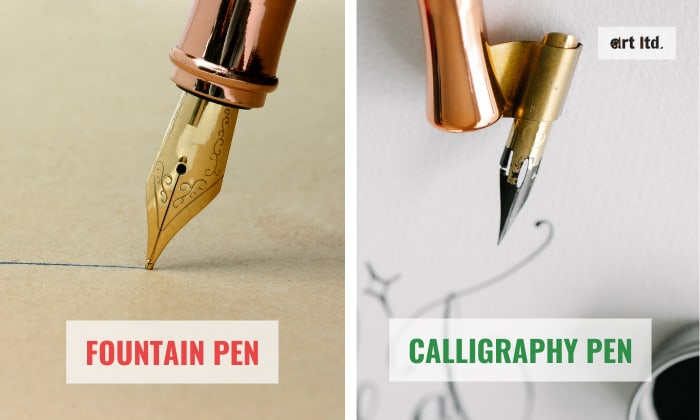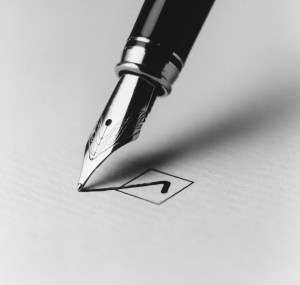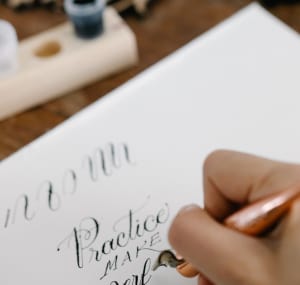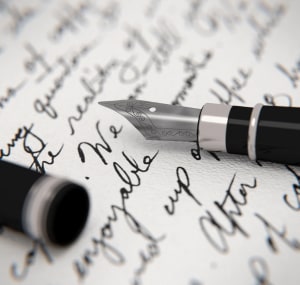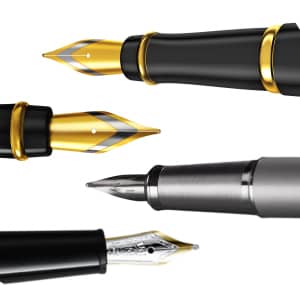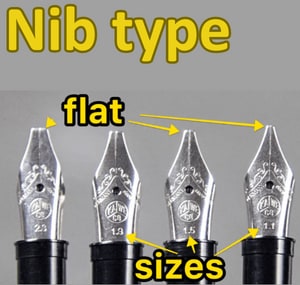Two well-known writing instruments that have endured for ages are the fountain pen and the calligraphy pen.
What’s a fountain pen and how does it work? Simply put, fountain pens provide a sophisticated touch to your writing and drawing tasks and take minimal skill to use.
Calligraphy pens, on the other hand, require more expertise to use. They are intended for creative activities such as lettering and calligraphy.
In this article, we will dig deeper into the world of fountain pen vs calligraphy pen and explore the creative features that make each tool special.
Table of Contents
A Brief Overview
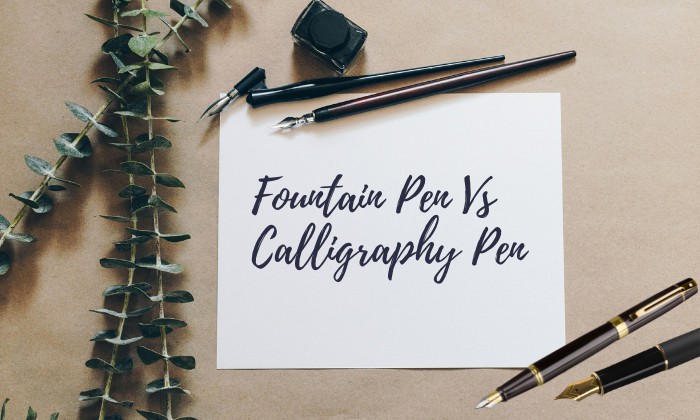
| Features | Fountain Pen | Calligraphy Pen |
| Writing Style | Adjustable pressure
Easy to write |
Thickness varies due to the angle of the stroke |
| Main Purpose | Multifunctional, common writing tasks, artistic expression | Calligraphy writing |
| Ink Type | Thin and liquid | Thick and viscous, bold effect |
| Body and Mechanism | Multiple parts, a refillable ink reservoir, and a nib | Simple holder and nib |
| Cost | $30-$100 | 5-$60 |
| Nib Type | Round nib, including extra-fine, bold, and medium. | Small-sized and flat nib |
Difference Between Fountain Pens and Calligraphy Pens?
1. Fountain pen
A fountain pen uses a pointed metal nib to apply paper-based ink. It includes an internal ink reservoir.
It uses a mechanism that pulls the ink from its reservoir through a feed to its nib and dispenses it on paper using a unique combination of capillary as well as gravity action.
Fountain pens typically use an internal filling process that generates suction or a vacuum to distribute ink through the nib into the reservoir.
A syringe or an eyedropper can also be used to manually fill the ink reservoir.
In addition, some fountain pens include pre-filled ink cartridges that can be taken out and replaced.
Read more: History of fountain pens.
2. Calligraphy pen
This writing tool is normally composed of a nib and a holder. Hand pressure plays an integral role in making it work properly. Applying controlled pressure to the nib will dispense ink smoothly, whilst too little pressure will not.
This causes line variations in your lettering, making a calligraphy pen set a unique tool for creative handwriting.
A dip pen is the most common type of calligraphy pen. As you learn the basics and other wonders of calligraphy, you may want to experiment with different pens, such as pencils, brush pens, or markers.
Some users, however, believe that any pen used for calligraphy can be referred to as a calligraphy pen. Interestingly, some artists use a fountain pen for calligraphy.
The Similarities of Fountain Pen and Calligraphy Pen
1. Sleek design
These pens feature long, fancy, and slim designs, distinguishing them from ordinary ballpoint or gel pens. They are refillable, thus environmentally friendly.
2. Smooth writing experience
Ballpoint pens cannot compare to the writing experience offered by fountain pens and pens for calligraphy writing. The ink flow is steady and fluid, and the flexibility and shape of the nibs add an expressive flair to the writing or artwork.
3. Use on 80 gsm to 120 gsm Paper
When you use calligraphy pens and fountain pens, correct paper choice is a must. Indeed, using low-quality paper for these pens can result in ink bleeding, smudging, or blurring, resulting in poor writing or drawing results.
Papers ranging from 80 gsm to 120 gsm papers would be ideal.
4. Slight similarities in nib usage
Fountain and calligraphy pens have a metal nib that touches the paper to release ink and produce written text or artwork. Although their nibs appear very similar, with a pointed, polished appearance and a small indentation in the center, they still differ slightly.
Differences Between Fountain Pen and Calligraphy Pen
1. Writing style
- Minimal effort is required when you write with a fountain pen. Just make sure to keep a steady angle while writing. Thus, the pressure exerted on the nib allows you to produce either thin or thick strokes.
- When writing or drawing with calligraphy pens, the variation in thickness will be produced by manually adjusting the orientation or angle of the stroke.
Read more:
2. Main purpose
- Calligraphy is an advanced art medium that is mainly characterized by varied line widths, various letter shapes, and other distinguishing characteristics.
It is a writing or drawing style intended for people who wish to produce picturesque and expressive works of art.
- Fountain pens, on the other hand, provide a multifunctional writing tool that can be utilized for artistic expression since interchangeable nibs like the stub nib are available. But, you cannot always write calligraphy with fountain pen.
Furthermore, fountain pens are ideal for everyday writing tasks, including journaling, taking notes, letter writing, and even watercolor painting.
3. Ink type
Now, let us talk about calligraphy ink vs fountain pen ink.
- With its thin and liquid consistency, fountain pen ink glides lightly and effortlessly across the page.
- Calligraphy ink, on the contrary, is typically formed of a thick, rich, and sticky texture that draws interest and leaves a bold effect.
Fountain pens also come with its ink reservoir to be refilled in various methods, ranging from a cartridge to a piston filling system.
In contrast, calligraphy pens may or may not contain an ink reservoir. Rather, they often feature a simple handle attached to the nib. So, to get a calligraphy pen to work you should dip the pen straight into an ink container for a genuine and classic calligraphy experience.
4. Body and mechanism
Let us now weigh calligraphy pen vs fountain pen when it comes to their barrel design and internal mechanism.
Calligraphy pens feature a more straightforward design than fountain pens. Unlike fountain pens that usually come with refillable reservoirs, a calligraphy pen may not be able to hold ink continuously.
The body of a fountain pen, on the other hand, is composed of multiple parts, which include the ink reservoir, the feed, and the nib.
5. Cost
While low to mid-quality fountain pens and calligraphy pens usually fall into the $5 to $30 price bracket, there is still a noticeable price difference between the two, especially for higher-end options.
A good fountain pen set may range in price from $30 to $100, and the premium versions such as the Montblanc Fountain Pen are priced over $1,000!
Meanwhile, a fountain pen like the Lamy Safari costs approximately $25, whereas equivalent calligraphy pens such as Sanford calligraphy pens or Staedtler calligraphy pens, only cost around $15.
When comparing higher-end options, the Pilot Custom 823 Fountain Pen, noted for its superb workmanship and stylish appearance, costs roughly $285, while a top-quality calligraphy pen set, such as the Sheaffer calligraphy pen set, only costs around $60.
Even a specialized oblique pen for calligraphy such as the Speedball Oblique Pen Set only costs around $13.
6. Nib type
Fountain pens feature a round nib, but when you write with a calligraphy pen, you will notice that it has a flat nib.
Both of these pens offer nib sizes ranging from extra-fine to broad, with calligraphy nib sizes that are usually measured in millimeters. Calligraphy nibs are also a little more flexible, which allows for more artistic lettering.
Pros and Cons
1. Fountain pen
- Provide a more comfortable writing experience
- They offer more expressive and customized writing styles
- Environmentally friendly and cost-effective in the long run
- Ergonomic to write with and require less pressure
- Feature interchangeable nibs to accommodate a variety of writing and drawing needs
- Expensive
2. Calligraphy pen
- Provide accurate, fine lines that are ideal for delicate lettering
- The distinctive, flat nibs produce varying line thicknesses
- Available in a variety of sizes to meet various writing styles and preferences
- Easily accessible tools for both beginners and experts
- Affordable
- Needs a certain level of skill or expertise to use correctly
Frequently Asked Questions
Can you use a calligraphy pen with fountain pen ink?
Generally speaking, yes. Some types of fountain pens are available for writing pointed pen calligraphy.
However, due to differences in ink viscosity and formulation, using a fountain pen in certain calligraphy projects may not achieve the desired effect.
Are fountain pens good for calligraphy?
Yes! Although not all fountain pens are suitable for calligraphy, certain fountain pen models can be adjusted with the correct nib shape and size.
What is the difference between a dip pen and fountain pen?
When comparing a fountain pen vs dip pen, dip pens lack an internal reservoir or ink storage.
Instead, the user dips the pen nib into ink between lines of writing or drawing, and the interchangeable metal nibs retain the ink, whereas the solid handle remains steady.
What not to do with a fountain pen?
Incompatible ink may clog or harm the sophisticated mechanisms of the pen.
Incorrect paper type may result in feathering or bleeding.
Putting an inked pen in a drawer, bag, or container can dry out the ink.
Pressing too hard on the nib and springing it can result in permanent damage.
Inappropriate ink refilling.
Conclusion
Although fountain pens provide ultimate precision, convenience, and creativity, calligraphy pens offer versatility, affordability, and a one-of-a-kind writing experience.
Fountain pens and calligraphy pens share many similarities. Still, they differ in several aspects including writing style, ink type, main purpose, body, mechanism, cost, and nib type.
In the end, it is not about fountain pen vs calligraphy pen. Instead, it is about finding the pen that best suits your personal preferences and intended usage.

Art has always been a part of my life; it influences my upbringing and later my career choice. For me, it is always a part of my parenting technique. So for whichever purpose that you come to art, you can start here with us.
